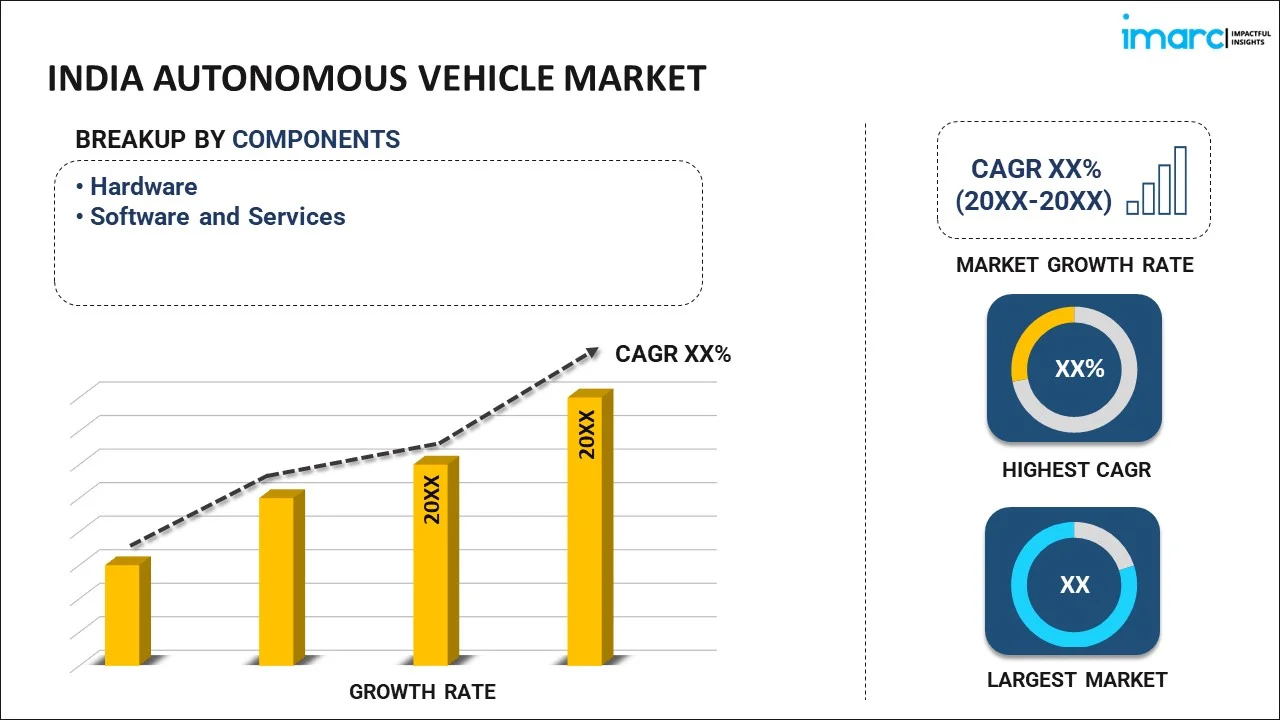
India Autonomous Vehicle Market Report by Component (Hardware, Software and Services), Level of Automation (Level 3, Level 4, Level 5), Application (Transportation and Logistics, Military and Defense), and Region 2025-2033
Market Overview:
The India autonomous vehicle market size reached USD 2.6 Billion in 2024. Looking forward, IMARC Group expects the market to reach USD 23.3 Billion by 2033, exhibiting a growth rate (CAGR) of 24.3% during 2025-2033.
|
Report Attribute
|
Key Statistics
|
|---|---|
|
Base Year
|
2024
|
|
Forecast Years
|
2025-2033
|
|
Historical Years
|
2019-2024
|
| Market Size in 2024 | USD 2.6 Billion |
| Market Forecast in 2033 | USD 23.3 Billion |
| Market Growth Rate 2025-2033 | 24.3% |
Autonomous vehicles, also known as driverless cars or self-driving cars, can operate by themselves and perform necessary functions by analyzing and sensing their surroundings with minimal to no human intervention. Equipped with artificial intelligence (AI) software, light detection and ranging (LiDAR), radio detection and ranging (RADAR), and sensor-integrated cameras, they can create an active 3D map of their surroundings. These 3D maps track the motion sequences of 3D structures based on corresponding points in images, assist the vehicles to continuously monitor the surrounding environment and maneuver independently. Additionally, these automobiles deploy connected technology to facilitate vehicle-to-vehicle and infrastructure-to-vehicle communication, which results in effective traffic management. Some of the other advantages offered by autonomous vehicles include enhanced safety features, less battery operation costs, and reduced fuel consumption and emissions.
India Autonomous Vehicle Market Trends:
The market is primarily driven by continual technological advancements in the automotive sector across the country, which results in the increasing adoption of the Internet of Things (IoT), machine learning (ML) and artificial intelligence (AI). Moreover, the augmenting installation of smart traffic lights and connected infrastructure in toll booths, car parks to reduce traffic congestion is providing an impetus to the market. In addition to this, the inflating disposable incomes of the masses are creating a positive market outlook. The market is further driven by the incorporation of advanced features, such as automatic emergency braking (AEB) and lane departure warning (LDW), that augment self-driving capabilities in cars while ensuring low risks of accidents. Some of the other factors creating lucrative growth opportunities include stringent government regulations focusing on increasing road safety and extensive research and development (R&D) activities conducted by key players in India.
Key Market Segmentation:
IMARC Group provides an analysis of the key trends in each sub-segment of the India autonomous vehicle market report, along with forecasts at the country and regional level from 2025-2033. Our report has categorized the market based on component, level of automation and application.
Breakup by Component:

- Hardware
- Software and Services
Breakup by Level of Automation:
- Level 3
- Level 4
- Level 5
Breakup by Application:
- Transportation and Logistics
- Military and Defense
Breakup by Region:
- North India
- West and Central India
- South India
- East India
Competitive Landscape:
The competitive landscape of the industry has also been examined along with the profiles of the key players.
Report Coverage:
| Report Features | Details |
|---|---|
| Base Year of the Analysis | 2024 |
| Historical Period | 2019-2024 |
| Forecast Period | 2025-2033 |
| Units | Billion USD |
| Segment Coverage | Component, Level of Automation, Application, Region |
| Region Covered | North India, West and Central India, South India, East India |
| Customization Scope | 10% Free Customization |
| Post-Sale Analyst Support | 10-12 Weeks |
| Delivery Format | PDF and Excel through Email (We can also provide the editable version of the report in PPT/Word format on special request) |
Key Questions Answered in This Report
We expect the India autonomous vehicle market to exhibit a CAGR of 24.3% during 2025-2033.
The introduction of advanced product variants that are equipped with internet connectivity, safety alerts, automatic crash notifications, etc., along with the growing need for efficient mode of transportation, is primarily driving the India autonomous vehicle market.
The sudden outbreak of the COVID-19 pandemic had led to the implementation of stringent lockdown regulations across the nation, resulting in the temporary closure of numerous manufacturing units for autonomous vehicles.
Based on the component, the India autonomous vehicle market can be segmented into hardware and software and services. Currently, hardware holds the majority of the total market share.
Based on the level of automation, the India autonomous vehicle market has been divided into level 3, level 4, and level 5. Among these, level 3 currently exhibits a clear dominance in the market.
Based on the application, the India autonomous vehicle market can be categorized into transportation and logistics and military and defense. Currently, transportation and logistics account for the largest market share.
On a regional level, the market has been classified into North India, West and Central India, South India, and East India.
Need more help?
- Speak to our experienced analysts for insights on the current market scenarios.
- Include additional segments and countries to customize the report as per your requirement.
- Gain an unparalleled competitive advantage in your domain by understanding how to utilize the report and positively impacting your operations and revenue.
- For further assistance, please connect with our analysts.
 Inquire Before Buying
Inquire Before Buying
 Speak to an Analyst
Speak to an Analyst
 Request Brochure
Request Brochure
 Request Customization
Request Customization




.webp)




.webp)












